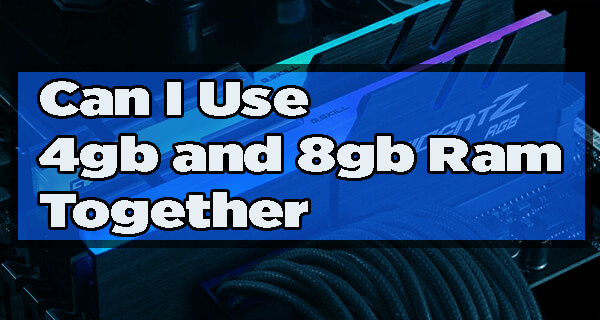In the ever-evolving realm of computer hardware upgrades, RAM stands as a beacon of performance enhancement. Yet, a common query often arises – “Can I use 4GB and 8GB RAM together?” This question is the gateway to a world of possibilities and considerations.

In this exploration, we embark on a journey to decode the intricacies of combining varying RAM capacities. We’ll unravel the mysteries surrounding the fusion of 4GB and 8GB RAM modules, understanding how they coexist harmoniously, and how you can optimize your system’s performance while doing so. Read: [8GB Vs 16GB Vs 32GB]
Understanding RAM Basics –
Before diving into the world of mixing RAM, let’s establish a solid foundation by understanding some key RAM concepts.
What Is RAM?
RAM (Random Access Memory) is computer memory that provides fast data access to the CPU. It stores active data like running applications, the OS, and temporary files, improving multitasking and handling resource-intensive tasks with more RAM.
The Importance of RAM Speed:
RAM speed, measured in MHz or GHz, directly affects data access and system performance, especially for memory-intensive tasks like gaming, video editing, or virtual machines.
Mixing RAM Capacities –
Now, let’s address the burning question: Can you use 4GB and 8GB RAM sticks together in the same system?
Mixing RAM Capacities: The Basics
Indeed, combining 4GB and 8GB RAM sticks in a single system is possible. Yet, certain essential factors warrant consideration:
a) Compatibility Is Key –
i) Compatibility of RAM Types:
The RAM modules you mix should be of the same type, DDR3 with DDR3 or DDR4 with DDR4, for example. Mixing different RAM types may result in compatibility issues.
ii) Matching Speeds:
Ideally, the RAM sticks should have the same speed (MHz) to ensure stable performance. Mixing different speeds can lead to the system running at the speed of the slower module.
iii) Dual-Channel Considerations:
Dual-Channel Tip: For optimal performance, it’s advised to install RAM in pairs or sets of the same size and speed.
b) Dual-Channel & Single-Channel:
i) Dual-Channel Memory:
Dual-channel memory configuration involves installing identical RAM modules in pairs or multiples. This setup allows the CPU to access data from two modules randomly, improving performance compared to single-channel configurations.
ii) Single-Channel Memory:
Single-Channel Memory: In this setup, either a single RAM module or mismatched modules are used. While it functions, it doesn’t fully leverage the system’s maximum speed potential.
Mixing RAM Brands –
Now that we’ve covered mixing RAM capacities, let’s tackle another common question: Can you mix RAM brands with the same speed?
a) The Compatibility of Mixing RAM Brands:
Yes, you can mix RAM brands with the same speed, but there are some potential issues to be aware of:
b) Differences in Timing and Compatibility:
Timing and Latency: RAM modules from different manufacturers may have slightly different timing and latency settings. This can result in compatibility issues or require manual adjustment in the BIOS to ensure stability.
c) XMP Profiles:
Some RAM modules come with XMP (Extreme Memory Profile) settings that optimize their performance. Mixing different brands may not allow you to use XMP profiles to their fullest potential.
Practical Solutions & Tips –
Now that we’ve discussed mixing RAM capacities and brands, let’s explore some practical solutions and tips to ensure a smooth experience when using 4GB and 8GB RAM sticks together.
a) Check Your Motherboard’s Manual:
Before mixing RAM, consult your motherboard’s manual to understand its specific compatibility requirements and recommendations.
b) Balance Capacities:
To achieve a balanced configuration, pair 4GB and 8GB RAM sticks in dual-channel mode. For instance, install two 4GB sticks and one 8GB stick for a total of 16GB in a triple-channel configuration. This can help optimize both capacity and speed.
c) Update Your BIOS:
Ensure your motherboard’s BIOS is up to date. Manufacturers often release BIOS updates that improve RAM compatibility and stability.
d) Run MemTest:
Use MemTest or a similar diagnostic tool to check for RAM stability and errors. This can help identify any issues with your mixed RAM configuration.
e) Manual Timing Adjustments:
If you encounter compatibility issues, you may need to manually adjust RAM timings and voltage settings in the BIOS. Be cautious when doing this, as improper settings can lead to system instability.
f) Consider Future Upgrades:
While mixing RAM capacities can provide a short-term solution, consider investing in a matched set of RAM modules in the long run for better performance and stability.
Conclusion:
Our exploration into the realm of mixing 4GB and 8GB RAM modules has illuminated the possibilities and considerations that arise when striving for a balanced, high-performance computer system.
To answer the burning question, yes, it is possible to use 4GB and 8GB RAM together, but it requires thoughtful planning and adherence to certain principles. Compatibility between RAM types, matching speeds, and the recognition of dual-channel benefits are critical aspects to consider.
Dual-channel configurations, achieved by pairing identical RAM modules, deliver a noticeable boost in system performance, making multitasking and demanding tasks like gaming or content creation smoother and more efficient.
In this tech-savvy world, updates and adjustments are constant companions. Keeping your system up to date, running diagnostics to ensure stability, and considering future upgrades are all part of the journey to creating a well-balanced and high-performing computing environment.
As we conclude, remember that technology continues to evolve. While mixing 4GB and 8GB RAM can provide an immediate performance boost, investing in a matched set of RAM modules remains the gold standard for long-term stability and top-tier performance.
So, as you embark on your RAM upgrade expedition, armed with the knowledge acquired in this guide, you can confidently embrace the fusion of 4GB and 8GB RAM in your system. Unleash their combined power, optimize your computer’s capabilities, and navigate the modern digital landscape with ease and efficiency.
Read also: 12GB RAM Vs 16GB RAM: Difference & Which is better for Gaming?
